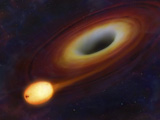|
|
TODAY.AZ / Weird / Interesting
Ultra-Bright Burst of Light marks the death throes of a star being eaten alive
18 June 2011 [13:11] - TODAY.AZ
 Astronomers have solved the mystery of a gargantuan cosmic explosion first spotted in March: A black hole did it, by killing and eating a star the size of our sun.
Astronomers have solved the mystery of a gargantuan cosmic explosion first spotted in March: A black hole did it, by killing and eating a star the size of our sun.A couple months ago, we told you about an unusually bright and long-lasting blast of energy emanating from the center of a galaxy 3.8 billion light-years away in the constellation Draco. At first, astronomers thought it was a gamma-ray burst from a collapsing star, but when it kept shining in a variable pattern (brightening and fading) scientists realized it wasn’t your average GRB.
Astronomer Joshua Bloom at the University of California-Berkeley suspected it was a high-energy jet produced as a sun-sized star fell into a black hole and was torn to pieces. Bloom and researchers from several other institutions in the US and UK started analyzing data from the Swift Gamma Burst Mission, which first spotted the blaze of glory, as well as the Hubble Space Telescope, the Chandra X-ray Observatory and the Keck Observatory. Their analysis confirmed the theory, and was published Thursday in Science Express.
As tidal forces tear the star to pieces, some of the star’s mass is turned into energy. Some of that energy radiates as x-rays and gamma ray jets that spew from the swirling disk of star guts. The variable brightness is the result of new flares that occurred as more chunks of the destroyed star fell into the black hole, researchers said. Earth happened to be directly in the path of one of those gamma ray jets, which is why it looked so incredibly bright, scientists said.
By the way, this is still going on, more than two months later. Most star-death events last a matter of hours or maybe days, not weeks or months. (This star really died about 3.8 billion years ago.)
The black hole in question has a mass about six or seven times that of the sun, but that’s not really that big in terms of active galactic nuclei. Massive black holes, as compared to supermassive black holes, can quietly munch on gas for long periods of time, and roar to life when something wanders too close. That seems to be what happened here, Bloom said in a Cal news release.
“Here, you have a black hole sitting quiescently, not gobbling up matter, and all of a sudden something sets it off,” he said. “This could happen in our own galaxy, where a black hole sits at the center living in quiescence, and occasionally burbles or hiccups as it swallows a little bit of gas. From a distance, it would appear dormant, until a star randomly wanders too close and is shredded.”
This is a very rare event, and it’s even more unlikely that Earth would get such a great view, Bloom said — probably once in 100 million years in any given galaxy.
/Science Daily/
URL: http://www.today.az/news/interesting/88504.html
 Print version
Print version
Views: 2262
Connect with us. Get latest news and updates.
See Also
- 19 February 2025 [22:20]
Visa and Mastercard can return to Russia, but with restrictions - 05 February 2025 [19:41]
Japan plans to negotiate with Trump to increase LNG imports from United States - 23 January 2025 [23:20]
Dubai once again named cleanest city in the world - 06 December 2024 [22:20]
Are scented candles harmful to health? - 23 November 2024 [14:11]
Magnitude 4.5 earthquake hits Azerbaijan's Lachin - 20 November 2024 [23:30]
Launch vehicle with prototype of Starship made its sixth test flight - 27 October 2024 [09:00]
Fuel prices expected to rise in Sweden - 24 October 2024 [19:14]
Turkiye strikes terror targets in Iraq and Syria - 23 October 2024 [23:46]
Kazakhstan supplied almost entire volume of oil planned for 2024 to Germany in 9 months - 23 October 2024 [22:17]
Taiwan reported passage of Chinese Navy aircraft carrier near island
Most Popular
 What von der Leyen doesn't know about. Or doesn't want to know
What von der Leyen doesn't know about. Or doesn't want to know
 Culture Minister meets with Kyrgyz counterpart in Bishkek
Culture Minister meets with Kyrgyz counterpart in Bishkek
 Turkish auto sector shifts gears for green transformation
Turkish auto sector shifts gears for green transformation
 Japan grants $3 billion loan to Ukraine using profits from frozen Russian assets
Japan grants $3 billion loan to Ukraine using profits from frozen Russian assets
 America’s tariff strategy risks fragmenting global economy
America’s tariff strategy risks fragmenting global economy
 At least 148 dead after boat accident on DR Congo river
At least 148 dead after boat accident on DR Congo river
 Uzbekistan, South Korea discuss easing visa rules, expanding seasonal work opportunities
Uzbekistan, South Korea discuss easing visa rules, expanding seasonal work opportunities
